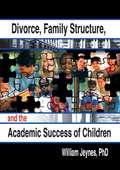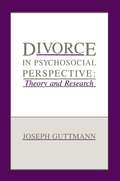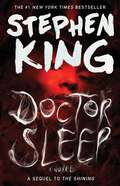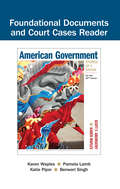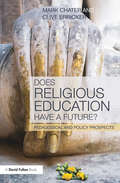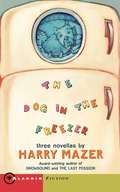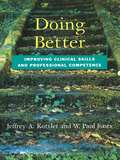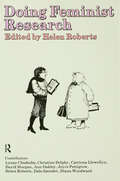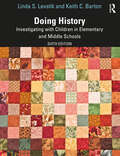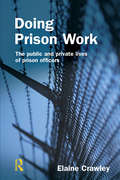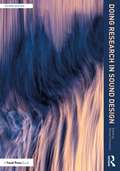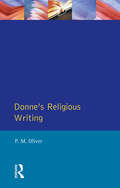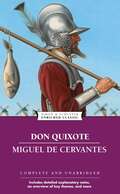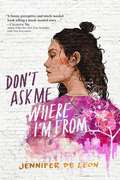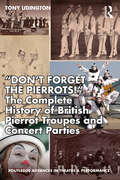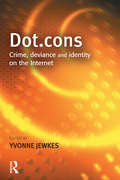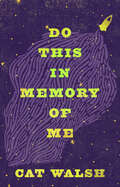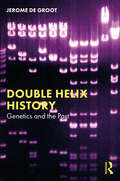Special Collections
Benetech’s Global Certified Accessible Titles
Description: Benetech’s GCA program is the first independent third-party EPUB certification to verify ebook accessibility. By creating content that is born accessible, publishers can meet the needs of all readers. Learn more: https://bornaccessible.benetech.org/
- Table View
- List View
Divorce, Family Structure, and the Academic Success of Children
by William JeynesTrace the influence of family factors on children's emotional and educational well-being!The effect of family changes on children's academic success is a new subject for study. Divorce, Family Structure, and the Academic Success of Children is a comprehensive volume that brings research on this hotly debated topic up to date. With clear tables and incisive arguments, it is a single-volume reference on this vexing sociocultural problem. Divorce, Family Structure, and the Academic Success of Children offers a close look at the historical background and current theory of this field of study. But it is more than a compendium of known facts and completed studies. It examines issues of appropriate methodology and points out concerns for planning future research. Divorce, Family Structure, and the Academic Success of Children summarizes current knowledge of the effects of various influences on children's emotional and educational well-being, including: divorce and remarriage single-parent families nontraditional family structures race socioeconomic status mobility Educators, theorists, sociologists, and psychologists will find this volume an essential resource. With hundreds of useful references and clear organization, it presents new ideas in an easy-to-use format that makes it an ideal textbook as well.
Divorce in Psychosocial Perspective
by Joseph GuttmannMany books deal with divorce and its aftermath -- some deal with the impact of divorce on children and families, others with the legal or sociological aspects of divorce, and a few focus on divorced mothers and fathers. Most of these books are characterized by their practical orientation toward the issues and problems posed by divorce. None of these, however, have attempted to offer an integrated view of the massive amount of theoretical and research literature on divorced adults and their children. In addition, none present a comprehensive view of divorce as a psychological process within its larger social context. Filling that void, this book: * offers a comprehensive view of divorce as a social, interpersonal and psychological phenomenon, * reviews the theory and research on divorce focusing on the major protagonists of the divorce drama: the mother, the father and the children, and * introduces a social-psychological theory of divorce process.
Doctoral Student Skills
by Christopher L. PallasDoctoral Student Skills offers a comprehensive overview of the key skills doctoral students need to succeed in their studies and prepare for academic and non-academic jobs. Revealing the often-hidden rules of graduate school success, it guides students through challenges like selecting a research topic, choosing an advisor, preparing for conferences, publishing their work, and entering the job market. The book begins by explaining how to survey the job market and identify "signifiers" that will signal to future employers the student’s suitability for a job. It then guides students to reflect on their own experiences and abilities to identify their areas of comparative advantage. Providing detailed instructions on how to acquire key signifiers – including conference presentations, publications, grants, awards, and teaching experience – the volume prepares students for future professional success, while teaching them how to leverage these activities to enhance their progress in their present studies. The book is designed to be used as a course text or for self-study. Each chapter features reflective exercises that can be used individually or in small groups, along with recommended readings and additional resources to enhance student learning.
Doctor Sleep
by Stephen KingFrom master storyteller Stephen King, his unforgettable and terrifying sequel to The Shining—an instant #1 New York Times bestseller that is &“[a] vivid frightscape&” (The New York Times)—also a major motion picture starring Ewan McGregor!Years ago, the haunting of the Overlook Hotel nearly broke young Dan Torrance&’s sanity, as his paranormal gift known as &“the shining&” opened a door straight into hell. And even though Dan is all grown up, the ghosts of the Overlook—and his father&’s legacy of alcoholism and violence—kept him drifting aimlessly for most of his life. Now, Dan has finally found some order in the chaos by working in a local hospice, earning the nickname &“Doctor Sleep&” by secretly using his special abilities to comfort the dying and prepare them for the afterlife. But when he unexpectedly meets twelve-year-old Abra Stone—who possesses an even more powerful manifestation of the shining—the two find their lives in sudden jeopardy at the hands of the ageless and murderous nomadic tribe known as the True Knot, reigniting Dan&’s own demons and summoning him to battle for this young girl&’s soul and survival...
Document Reader for American Government
by Karen Waples and Scott AbernathyThis new offering from AP® teacher Karen Waples and college professor Scott Abernathy is tailor-made to help teachers and students transition to the redesigned AP® U. S. Government and Politics course. Carefully aligned to the course framework, this brief book is loaded with instructional tools to help you and your students meet the demands of the new course, such as integrated skills instruction, coverage of required cases and documents, public policy threaded throughout the book, and AP® practice after every chapter and unit, all in a simple organization that will ease your course planning and save you time. We’ve got you covered! With a program specifically tailored for the new AP® framework and exam. With a brief student edition that students will read and enjoy. With pedagogy and features that prepare students for the AP® exam like no other book on the market. With a teacher edition and resources that save you time in transitioning to the new course. With professional development to help you transition your instruction.
Does Religious Education Have a Future?
by Clive Erricker and Mark ChaterThe place of religion in the modern world has changed significantly over the past two decades. This has been partially reflected in the academic study of religion, but little, if at all, in religious education. In addition, the place of RE in schools has been the subject of intense debate due to changes to the curriculum and school structure, as well as being part of wider debates on religion in the public sphere. Written by two highly experienced leading practitioners of RE, Does Religious Education have a Future? argues for a radical reform of the subject based on principles of pedagogy set free from religious concerns. It challenges teachers, researchers and educators to rethink their approaches to, and assumptions about, religious education, and enables them to see their work in a larger context that includes pedagogical ideas and political forces. The book offers readers fresh, provocative and expertly informed critical perspectives on: the global context of RE, debates about religion in public places, religion’s response to modernity, violent extremism, science and secularism; the evolving educational rationale for RE in schools; the legal arrangements for RE and their impact on the teaching of the subject; the pedagogy of teaching approaches in RE and their effect on standards and perceptions of the subject; the educational commitment of faith/belief communities, and how this influences the performance of RE. Does Religious Education have a Future? proposes a new attitude to the subject of religious education, and a new configuration of both its role and content. This book is essential reading for academics, advisers and policy makers, as well as teachers of RE at primary and secondary levels and trainee and newly qualified teachers.
The Dog in the Freezer
by Harry MazerWhy is Jake carrying around a frozen dog?
Harry Mazer looks at aspects of boys and their dogs in three startlingly original novellas.
In the title story, "The Dog in the Freezer", a dog in Jake's New York City apartment building dies. Jake can't bear to see the body left for the garbagemen, so he embarks on a strange, funny, and frightening odyssey to bury it properly.
When Lucas, in "Puppy Love", has to spend the summer with his Uncle Jerry, a health nut, he finds two new interests, a girl and a dog. The girl is older and unattainable; the dog is wild and untrainable.
"My Life as a Boy" is a magical adventure story told by a brilliant dog who switches places with his master. The boy, Gregory, has a way of getting into impossible situations, and Einstein, his devoted dog, has a way of saving him.
These three novellas, varying in tone and style -- plus an original poem by Gina Mazer -- will speak to anyone who has ever loved a dog.
Doing Better
by W. Paul Jones and Jeffrey KottlerDoing Better is intended to help therapists and counselors to explore more fully and systematically the processes of self-improvement in their work and lives.
Doing Family Therapy, Fourth Edition
by Robert TaibbiEngaging, practical, and infused with clinical wisdom, this widely used text and practitioner guide helps therapists working with families to hit the ground running. The revised and updated fourth edition brings fresh insights into the issues families bring to therapy and the therapist's moment-to-moment decision making. Rather than advocating one best approach, Robert Taibbi shows that there are multiple ways to guide parents, children, and adolescents and harness their strengths. The beginning, middle, and end stages of treatment are richly illustrated with chapter-length case examples. End-of-chapter learning exercises help readers build key skills and creatively develop their own clinical style. New to This Edition *All chapters revised, with new case studies throughout. *Sidebars on common challenges facing new clinicians: self-doubt, the emotional experience of working with distressed families, and more. *Increased attention to what the therapist can say and do to actively shape each session. *Heightened focus on process--helping families explore the "how" of problem solving as much as the "what." See also the author's Doing Couple Therapy, Second Edition: Craft and Creativity in Work with Intimate Partners.
Doing Feminist Research
by H. RobertsFirst Published in 1981. Routledge is an imprint of Taylor & Francis, an informa company.
Doing Film Studies
by Claire Mortimer and Sarah Casey BenyahiaDoing Film Studies examines what it really means to study film, encouraging the reader to question the dominant theories as well as understanding the key approaches to cinema. This book provides an overview of the construction of film studies - including its history and evolution - and examines the application of theories to film texts. Important questions discussed include: Why does film studies need a canon? What is the relationship between authorship and genre theory? What is screen theory? How do we read a film text? Why is the concept of the spectator important to film? How is film involved in national identity? What is meant by a ‘film industry’? Aimed at students in their final year of secondary education or beginning their degrees, Doing Film Studies equips the reader with the tools needed in approaching the study of film.
Doing History
by Keith C. Barton and Linda S. LevstikNow in its sixth edition, Doing History offers a unique perspective on teaching and learning history in the elementary and middle grades. Through case studies of teachers and students in diverse classrooms and from diverse backgrounds, it shows children engaging in authentic historical investigations, often in the context of an integrated social studies curriculum. The book is grounded in the view that children can engage in valid forms of historical inquiry—asking questions, collecting and analyzing evidence, examining the varied perspectives and experiences of people in the past, and creating evidence-based historical accounts and interpretations. Grounded in contemporary sociocultural theory and research, the text features vignettes in each chapter showing communities of teachers and students doing history in environments rich in literature, art, writing, and discussion. The authors explain how these classrooms reflect contemporary principles of teaching and learning, and thus, the descriptions not only provide specific examples of successful activities but also place them in a context that allows teachers to adapt and apply them in a wide range of settings. Doing History emphasizes diversity in two ways: Readers encounter students from a variety of backgrounds and see how their diverse experiences can form the foundation for learning, and they also see examples of how teachers can engage students with diverse experiences and perspectives in the past, including those that led to conflict and oppression. The book also discusses principles for working with English learners and newcomers, and it provides guidance in using multiple forms of assessment to evaluate the specifically historical aspects of children’s learning. Updates to this edition include updated historical and instructional examples to ensure currency, new suggestions for children’s literature to support good teaching, expanded attention to teaching about oppressed groups in history, and greater attention to when historical perspective taking is and is not appropriate.
Doing Prison Work
by Elaine M CrawleyThis book provides a much-needed sociological account of the social world of the English prison officer, making an original contribution to our understanding of the inner life of prisons in general and the working lives of prison officers in particular. As well as revealing how the job of the prison officer - and of the prison itself - is accomplished on a day-to-day basis, the book explores not only what prison officers do but also how they feel about their work. In focusing on how prison officers feel about their work this book makes a number of interesting revelations - about the essentially domestic nature of much of the work they do, about the degree of emotional labour invested in it and about the performance nature of many of the day-to-day interactions between officers and prisoners. Finally, the book follows the prison officer home after work, showing how the prison can spill over into their home lives and family relationships. Based on extensive ethnographic fieldwork in different types of prisons (including interviews with prison officers' wives and children as well as prison officers themselves), this book will be essential reading for all those with an interest in how prisons and organisations more generally operate in practice.
Doing Research in Sound Design
by Michael FilimowiczDoing Research in Sound Design gathers chapters on the wide range of research methodologies used in sound design. Editor Michael Filimowicz and a diverse group of contributors provide an overview of cross-disciplinary inquiry into sound design that transcends discursive and practical divides. The book covers Qualitative, Quantitative and Mixed Methods inquiry. For those new to sound design research, each chapter covers specific research methods that can be utilized directly in order to begin to integrate the methodology into their practice. More experienced researchers will find the scope of topics comprehensive and rich in ideas for new lines of inquiry. Students and teachers in sound design graduate programs, industry-based R&D experts and audio professionals will find the volume to be a useful guide in developing their skills of inquiry into sound design for any particular application area.
The Domain Name Registration System
by Jenny NgThis book offers a comparative analysis of the domain name registration systems utililsed in Australia and the United Kingdom. Taking an international perspective, the author analyses the global trends and dynamics of the domain name registration systems and explores the advantages and disadvantages of restrictive and less restrictive systems by addressing issues of consumer protection. The book examines the regulatory frameworks in the restrictive and unrestrictive registration systems and considers recent developments in this area. Jenny Ng also examines the legal and economic implications of these regulatory frameworks, drawing upon economic theory, regulatory and systems theory as well as applying rigorous legal analysis. In doing so, this work proposes ways in which such systems could be better designed to reflect the needs of the specific circumstances in individual jurisdictions. The Domain Name Registration System will be of particular interest to academics and students of IT law and e-commerce.
Domination and Global Political Justice
by Jonathan Trejo-Mathys and Barbara Buckinx and Timothy WaligoreDomination consists in subjection to the will of others and manifests itself both as a personal relation and a structural phenomenon serving as the context for relations of power. Domination has again become a central political concern through the revival of the republican tradition of political thought (not to be confused with the US political party). However, normative debates about domination have mostly remained limited to the context of domestic politics. Also, the republican debate has not taken into account alternative ways of conceptualizing domination. Critical theorists, liberals, feminists, critical race theorists, and postcolonial writers have discussed domination in different ways, focusing on such problems as imperialism, racism, and the subjection of indigenous peoples. This volume extends debates about domination to the global level and considers how other streams in political theory and nearby disciplines enrich, expand upon, and critique the republican tradition’s contributions to the debate. This volume brings together, for the first time, mostly original pieces on domination and global political justice by some of this generation’s most prominent scholars, including Philip Pettit, James Bohman, Rainer Forst, Amy Allen, John McCormick, Thomas McCarthy, Charles Mills, Duncan Ivison, John Maynor, Terry Macdonald, Stefan Gosepath, and Hauke Brunkhorst.
Donne's Religious Writing
by P. M. OliverThis, the first book to focus solely on Donne's religious writing, also places his work in a literary context and attempts to reach a more realistic assessment of its originality than has been possible hitherto. The prose works that are examined in detail include the controversial treatises Bianthanatos and Pseudo-Martyr, the satirical Ignatius His Conclave, the much-quoted Essays and Devotions and, of course, Donne's sermons.
Don Quixote
by Miguel De CervantesThe Enriched Classics series offers readers such features as:
* A concise introduction that gives the reader important background information
* A chronology of the author's life and work
* A timeline of significant events that provides the book's historical context
* An outline of key themes and plot points to help guide the reader's own interpretations
* Detailed explanatory notes
* Critical analysis, including contemporary and modern perspectives on the work
* Discussion questions to promote lively classroom and book group interaction
* A list of recommended related books and films to broaden the reader's experience
[This text is listed as an example that meets Common Core Standards in English language arts in grades 11-12 at http://www.corestandards.org.]
Don't Ask Me Where I'm From
by Jennifer De LeonFirst-generation American LatinX Liliana Cruz does what it takes to fit in at her new nearly all-white school. But when family secrets spill out and racism at school ramps up, she must decide what she believes in and take a stand.Liliana Cruz is a hitting a wall—or rather, walls.
There’s the wall her mom has put up ever since Liliana’s dad left—again. There's the wall that delineates Liliana’s diverse inner-city Boston neighborhood from Westburg, the wealthy—and white—suburban high school she’s just been accepted into. And there’s the wall Liliana creates within herself, because to survive at Westburg, she can’t just lighten up, she has to whiten up. So what if she changes her name? So what if she changes the way she talks? So what if she’s seeing her neighborhood in a different way? But then light is shed on some hard truths: It isn’t that her father doesn’t want to come home—he can’t…and her whole family is in jeopardy. And when racial tensions at school reach a fever pitch, the walls that divide feel insurmountable. But a wall isn’t always a barrier. It can be a foundation for something better. And Liliana must choose: Use this foundation as a platform to speak her truth, or risk crumbling under its weight.
“Don’t Forget The Pierrots!'' The Complete History of British Pierrot Troupes & Concert Parties
by Tony LidingtonThis volume is the first authoritative historical textbook to look at the origins, development and evolution of seaside pierrot troupes and concert parties and their popular performance heritage. It will provide, for the first time, a definition of the pierrot troupe and its evolution from the roots of European popular traditions such as the commedia dell’arte and minstrelsy, to links between music hall and contemporary popular culture. Tony Lidington will explore how pierrot troupes grew from a single idea into a major international cultural industry and how it boosted morale and national identity during the two World Wars, before sublimating into contemporary pop music and comedy. Tony’s continuing practice as research provides an experiential framework for the historical and ethnographic analysis of the form. This book will be of vital interest to students, researchers, and performers of outdoor (al fresco) arts, clowning and comedy, minstrelsy, vernacular music-making and music hall.
Don't Let It Get You Down
by Savala NolanA powerful and provocative collection of essays that offers poignant reflections on living between society’s most charged, politicized, and intractably polar spaces—between black and white, rich and poor, thin and fat.
Savala Nolan knows what it means to live in the in-between. Descended from a Black and Mexican father and a white mother, Nolan’s mixed-race identity is obvious, for better and worse. At her mother’s encouragement, she began her first diet at the age of three and has been both fat and painfully thin throughout her life. She has experienced both the discomfort of generational poverty and the ease of wealth and privilege. It is these liminal spaces—of race, class, and body type—that the essays in Don’t Let It Get You Down excavate, presenting a clear and nuanced understanding of our society’s most intractable points of tension.
The twelve essays that comprise this collection are rich with unforgettable anecdotes and are as humorous and as full of Nolan’s appetites as they are of anxieties. The result is lyrical and magnetic. In “On Dating White Guys While Me,” Nolan realizes her early romantic pursuits of rich, preppy white guys weren’t about preference, but about self-erasure. In the titular essay “Don’t Let it Get You Down,” we traverse the cyclical richness and sorrow of being Black in America as Black children face police brutality, “large Black females” encounter unique stigma, and Black men carry the weight of other people’s fear. In “Bad Education,” we see how women learn to internalize rage and accept violence in order to participate in our culture. And in “To Wit and Also” we meet Filliss, Grace, and Peggy, the enslaved women owned by Nolan’s white ancestors, reckoning with the knowledge that America’s original sin lives intimately within our present stories.
Over and over again, Nolan reminds us that our true identities are often most authentically lived not in the black and white, but in the grey of the in-between. Perfect for fans of Heavy by Kiese Laymon and Bad Feminist by Roxane Gay, Don’t Let It Get You Down delivers an essential perspective on race, class, bodies, and gender in America today.
Don't Worry (It's Safe to Eat)
by Andrew RowellAn investigation of science, politics and our food production system, this text exposes the bogus science, political interference and flawed policies that threaten our food supply. The author tells the story of BSE, revealing how top scientists have been muzzled and how the epidemic continues. Then, against a backdrop of burning cows, Andrew Rowell exposes how trade and macro-economic policies overruled good science in the foot and mouth catastrophe. He also opens the black box of the so-called GM revolution to expose the myth behind the marketing. In tracing how critics are silenced in the bottom-line climate of commercialized science and privatized knowledge, Rowell tells the true story of the widely publicized Pusztai GM potato scandal of the late 1990s and the ongoing Mexican maize GM contamination affair. Finally, the book offers radical solutions to make science work in the public interest and provide food that really is safe to eat.
Dot.cons
by Yvonne JewkesCyberspace opens up infinitely new possibilities to the deviant imagination. With access to the Internet and sufficient know-how you can, if you are so inclined, buy a bride, cruise gay bars, go on a global shopping spree with someone else's credit card, break into a bank's security system, plan a demonstration in another country and hack into the Pentagon ? all on the same day. In more than any other medium, time and place are transcended, undermining the traditional relationship between physical context and social situation. This book crosses the boundaries of sociological, criminological and cultural discourse in order to explore the implications of these massive transformations in information and communication technologies for the growth of criminal and deviant identities and behaviour on the Internet. This is a book not about computers, nor about legal controversies over the regulation of cyberspace, but about people and the new patterns of human identity, behaviour and association that are emerging as a result of the communications revolution.
Do This In Memory of Me
by Cat WalshTwelve-year-old Genevieve has been having a hard time at home, and all she really wants is to be an altar server at her church. Except it’s 1963 and Father Paul tells her that’s not allowed. After having her dreams crushed and being made fun of by her classmate and star altar boy Martin, Genevieve prays to God hoping for an exception. Instead, a fourteen-year-old martyr from the fourth century, St. Pancras, appears and promises to get her an answer from God. But with her mom missing for weeks and Martin disappearing on his way home from school the next day, she fears her prayers have been answered in dire ways. This dark comedy dives into the expansive time between childhood and adolescence, exploring questions about the realities of home life to the possibilities of unknown worlds. Do This In Memory of Me is for anyone who has ever questioned the relationship between faith and trust or wondered where they fit in the bigger picture.
Double Helix History
by Jerome De GrootDouble Helix History examines the interface between genetics and history in order to investigate the plausibility of ‘new’ knowledge derived from scientific methods and to reflect upon what it might mean for the practice of history. Since the mapping of the human genome in 2001, there has been an expansion in the use of genetic information for historical investigation. Geneticists are confident that this has changed the way we know the past. This book considers the practicalities and implications of this seemingly new way of understanding the human past using genetics. It provides the first sustained engagement with these so-called ‘genomic histories’. The book investigates the ways that genetic awareness and practice is seemingly changing historical practice and conceptualisation. Linking six concepts – ‘Public’, ‘Practice’, ‘Ethics’, ‘Politics’, ‘Self’, and ‘Imagination – Double Helix History outlines the ways that genetic information, being postgenomic, the public life of DNA, and the genetic historical imaginary work on the body, on collective memory, on the historical imagination, on the ethics of historical investigation, on the articulation of history, and on the collection and interpretation of data regarding the ‘past’. This book will appeal to researchers and students alike interested in DNA, genetics, and historiography.
